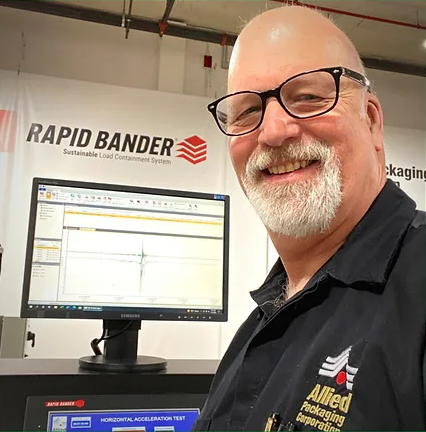Ask Steve
October 19, 2023
Question from Sally: We are experiencing a lot of load failures between our plant and warehouse, which is just about 5 miles away. There are no bumps, few turns, one stop light, and no hills. What could be causing the failures?
Hi Sally, I am very impressed with the great questions people in the industry are asking, and this is certainly one of them! Forces experienced during normal driving conditions (turning, start/stop, up and down hill) should not be sufficient to cause a load failure between your facilities if the pallets are properly wrapped. Let me explain why.
The fastest roller coaster will only generate about 1g (1 x your body weight) laterally, or sideways, in turns. If you have ridden on a roller coaster, you know what that force feels like. However, normal driving conditions will not even come close to that, in fact, it will be about 1/2g or less. Certainly not enough to cause a load failure in that short distance. Next let’s consider a panic stop, which will generate about 2g at most. It may seem that when a driver locks up the brakes, the force applied to the load is instantaneous, but it is not. A truck weighing 80,000 pounds traveling at 60mph has inertia (I won’t go into the math - yet). To stop that truck, you need to apply an equal and opposite force to the truck’s inertia. If the driver locks the brakes, and all eighteen wheels, that is an opposite force, but it is not an equal force because the contact patch of the tires and the grip with the road surface are not enough to equal the truck’s inertia. If you have ever seen a semi with the brakes locked, you know how far it takes for the truck to stop, especially if you are watching it skidding toward you in your rearview mirror! Now, for the math. If the truck is loaded and traveling 60mph, under ideal conditions, it will take at least 250 feet to stop. During that time, the skidding tires are providing an opposite force, constantly slowing the truck until it comes to a stop. So, the panic stops should not be sufficient to cause your load failures, especially considering the few stops they are making between the facilities.
Where does that leave us? The final type of force that acts on a load is an impact force. Let’s explore what happens in that case. An impact force occurs when a body in motion contacts one that is not, or not moving at the same speed. Imagine your driver backing toward the dock at your warehouse. Once the driver swings around and can back straight into the dock, they can average about 2.5 feet per second as they head toward the dock. Some drivers will slow as they approach the dock and barely kiss it when they stop. Others, however, are still traveling at a full 2.5 fps when they hit the dock bumpers. The inertia is met with an immediate equal and opposite force to the truck’s inertia, because of course, the building can’t move. In other words, the truck goes from 2.5 fps to 0 fps in a fraction of a second (actually, about 30 milliseconds). The resulting force exerted on the load can reach 5g or more. One last event that can generate a very high force in less than a second happens when the driver cuts a corner too tight, and the trailer jumps over a high curb.
Now we will channel Sherlock Holmes to put it all together and to solve the mystery!
The facts we know:
- There are relatively few turns and stops between facilities.
- Normal driving conditions will not generate the force needed to cause a load failure.
- Panic stops, while they do happen, are infrequent, especially in this case because the driver has only a few stops between facilities, and the force generated in a panic stop, while higher than normal driving conditions, should not cause the type of load failures you are experiencing.
- Through the process of elimination, the likely culprit is driver-related; either the driver is hitting dock bumpers too hard or jumping curbs. Either can generate the type of force that will cause a load failure if conventional stretch film is being used.
The next step is to have someone take a few photos of the load failures. If the loads fail toward the sides of the trailer, the driver is cutting a corner too tight and jumping a curb. If the loads are failing front-to-back, the driver is hitting the dock bumpers too hard. Once you know that, then some driver training may reduce your load failures, but that may only be a temporary fix.
One last piece of the puzzle remains, why are your loads failing on impact? I want to go back to a body in motion, will continue in motion until an equal and opposite for acts on it. That is fundamental in the study of load failures. The stretch film must apply that equal and opposite force to prevent the load from moving / shifting, just like a seat belt keeps you from hitting the steering wheel when you slam on the brakes. But what would happen if that seat belt stretched? It would not be very effective, right? The same is true for stretch film. If you don’t reach the level of stretch needed to stiffen the film (increasing resistance to further stretch), and you apply a force, such as jumping curbs or impacting dock bumpers, then the film will continue to stretch. We call that additional stretch secondary stretch. After secondary stretch, the load contents can move or shift, eventually leading to load failure. Our Rapid Bander, Rapid Roper, Rapid Roper Plus, and Rapid Film were developed to virtually eliminate secondary stretch. In your case, the driver is the variable, and you have limited control over that variable. The Rapid Bander will contain the load, even if the driver jumps curbs and impacts dock bumpers hard. You do not have to make a choice between load containment and cost, because with Rapid Bander, you will use substantially less film, reduce or eliminate web breaks during wrapping, reduce the number of wraps (meaning more machine time is available), and with all those benefits, it will still cost less per pallet.
We have been extremely successful at helping other companies with the same challenge you face. We will be happy to analyze your stretch wrap equipment, process, and load configuration, and then recommend a solution that will solve problems and bring value.
Thanks for asking!








